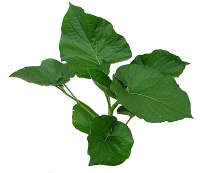Kava
 Overview
Overview
Kava is part of the Piperacea family, which includes black pepper. Other names include kava kava, awa, kew and tonga. The parts used are the roots and the rhizomes.
The people of the South Pacific have used kava the way Americans and many other cultures use beer - as a social drug.
History of Kava
Captain James Cook, an 18th Century British explorer, was offered kava during his voyage among the South Pacific islands from 1768 to 1771. It is said he and his crew enjoyed the peppery taste and its mildly intoxicating effect.
Polynesians have a tradition of partaking of kava in "kava circles." One or more of the participants places powdered kava root in half of a coconut shell and adds a cup of water to form a watery solution. Everyone claps as the drinker gulps the brew in one drink. The shell is passed to the next person and the ceremony is repeated until everyone has had several drinks. In the south Pacific, kava is used as a treatment for colds, arthritis, headache and arthritis. It is also used as an aphrodisiac and a sedative. Hawaiians took kava to alleviate their symptoms of asthma.
In the 1990s, American herbalists began to take an interest in kava. European research began to show that at lower doses than those used in South Pacific rituals the root produced little or no euphoria but continued to act as a mild tranquilizer.
Kava Constituents
The active compounds in kava are called kavalactones and have a tranquilizing effect which is similar to diazepam (Valium). These compounds are primarily found in the fat-soluble resin of the kava root. Kava, however, is less likely to cause sedation and it is not addictive.
Dried kava root contains about 43 percent starch, 12 percent water, 3.2 percent simple sugars, 3.6 percent proteins, 3.2 percent minerals (mostly potassium), and 15 percent kavalactones.
Kava Health Benefits
There are several German studies regarding the effectiveness of kava, and this research shows it is an effective treatment for anxiety and stress. In one study, 100 people who complained of anxiety and nervousness were given 300 milligrams of kava extract every day for 8 weeks or a placebo. Those taking the kava showed much less depression and anxiety. The benefits continued for the entire length of the six-month study.
Another study of individuals who complained of agoraphobia or social phobias found that 300 milligrams of kava for 8 weeks showed measurably less anxiety.
In another German study of 100 patients given 100 milligrams of kava three times daily, the effects of anxiety disorders began to lessen after just one week of treatment. No side effects were noted in the study participants.
In a study conducted at the Medical College of Virginia, the study group was given either a placebo or 240 milligrams of kava. The 60 adults in the program dealt better with stress and anxiety after 4 weeks into the research and had fewer interpsersonal problems, fewer symptoms of anxiety, and exhibited no side effects whatsoever.
Other studies have determined that kavalactones have sedative, analgesic, anticonvulsant, and muscle relaxant effects.
Kava also seems to be able to protect against brain damage due to ischemia. The effect was thought to be due to kava's ability to limit the infarct area as well as its mild, anticonvulsant effect. Thus, kava extract may prove to be useful when individuals are recovering from stroke.
Kava may also improve sleep.
Doses
Anywhere from 100 milligrams to 300 milligrams seems to be an effective dose of kava. The amount used in most research studies seems to be 300 milligrams daily. Kava is best used as a short-term treatment and can be used for up to a few months. A physician should be consulted if further medical help is needed when this timeframe is up.
Powdered bulk root is available in the South Pacific and other health food stores, but most individuals take kava in capsule form.
Anticipated improvements from kava use should be seen within two weeks.
One interesting note regarding kava is that while many people build up a tolerance to certain drugs and are less affected by their use, this is not the case with kava.
Adverse Reactions
In doses larger than 300 milligrams, kava appears to cause inebriation which is very similar to alcohol. The eyes can become bloodshot and thinking and coordination can become impaired. Taking large doses of kava for many years can cause kava dermopathy, which is the development of scaly skin. This side effect is very unlikely when taking the recommended dosage.
Kava should not be taken with alcohol or sedatives as the plant can intensify the effects of the other products. Allergic reaction is also possible when consuming kava. Kava may cause numbness of the mouth, which is harmless.
Kava is considered to be safe for women who are pregnant or nursing if they are otherwise in good health. A normal dosage should be taken by such individuals.
Kava should not be given to children who are under the age of two. For children who are older than two or adults who are over the age of 65, it may be wise to start with a weak dose of kava and work up to the recommended dosage of 300 milligrams daily.
References
- Bone, K. A Clinical Guide to Blending Liquid Herbs: Herbal Formulations for the Individual Patient, Churchill Livingstone (2003)
- Braun, L. & Cohen, M. Herbs & Natural Supplements: An evidence-based guide, Elsevier (2005)
- Duke, J. The Green Pharmacy: Herbal remedies for common diseases and conditions from the world's foremost authority on healing herbs, Rodale Limited (2003)
- Kowalchik, C. & Hylton, W. Rodale's Illustrated Encyclopedia of Herbs, Schwartz Books (1987)
Posted in Kava
Ask a Question Or Join a Discussion


